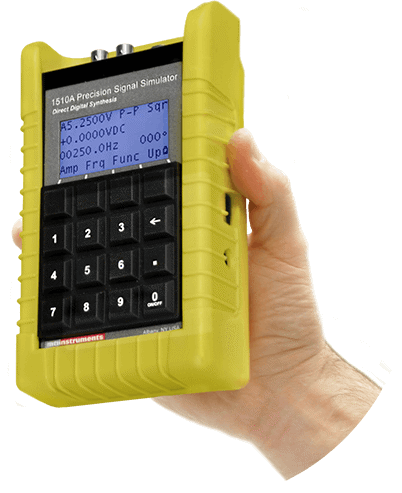 Interview conducted by Mychealla RiceNov 30 2017
Interview conducted by Mychealla RiceNov 30 2017In this interview, Don Welch, Director of New Business Development from MTI Instruments talks to AZoM about MTI's handheld signal source generator with dual-channel direct digital synthesis.
Please tell us a bit about the handheld signal generator?
The 1510A signal generator, sometimes called a signal source, is a unique and highly flexible instrument designed to facilitate precision testing. The handheld signal generator can generate voltage and charge signals over a wide range of frequencies so this makes fast work of system calibrations.
In addition, two digitally synthesized channels can be used to produce several types of wave shapes. This gives users the ability to calibrate most measurement systems. Accurate enough for a calibration shop, this small and rugged instrument is also good for factory, test cell, and flight line use.
Why did you decide to develop this signal generator? Was there a gap in the market?
The original intent was to build a signal generator to support our PBS-4100 data acquisition system which is used to balance jet engine turbines. Proper turbine balancing requires inputs from accelerometers as well as vibration and speed sensors. The 1510A simulates these signals.
It quickly became apparent that the 1510A could be used to simulate other types of sensors too, and we began to use it around MTI as a general-purpose test signal generator.
In a Eureka moment, we realized this tool might also be useful to our customers for their general-purpose repair, maintenance, and troubleshooting needs. This proved true as the instrument has become a valuable tool to many engineers and technicians from across a range of industries, and is used in awide variety of applications. We often hear from users who appreciate the time savings they gain when performing repair and troubleshooting activities with the 1510A.

The 1510A signal generator
How is the MTI Instruments signal generator different from other units on the market?
The signal generator is compact in size, battery operated and versatile. This makes it invaluable for testing a wide range of equipment via simulation of various signals. Additionally, the menu-based setup makes it simple to use, even with very little training.
Why does the signal generator have two channels?
It’s common that two different signals are needed simultaneously to simulate a sensor. For example, the 1510A handheld signal generator can output a digital signal to simulate a speed signal from a rotating piece of equipment while also outputting an analogue sinusoidal signal that is synchronous to the speed signal.
The instrument can even simulate sensors such as quadrature encoders requiring two simultaneous square waves phased 90 degrees apart.
How does the signal generator compare to other models on the market?
The 1510A Signal Generator is rather unique and not like conventional, general purpose signal generators with one output only. The 1510A Signal Generator is also portable.
Most other signal generators are designed as bench top instruments and must be plugged into an AC source. Battery operation also allows the signal generator to float (no power ground) which is handy for testing medical data acquisition systems.
In addition, complimentary outputs on the 1510A give the ability to simulate signals from rotating equipment – another unique feature.
Please tell us about the features of the signal source generator?
The main features of the 1510A Signal Generator include;
- 0.05% accuracy
- dual frequency synthesizers
- twin mode signal outputs
- multiple output wave shapes
The 1510A produces tachometer generator speed signals as well as odd-tooth type signals for simulating a wide range of engine and machinery speed signals.
JOG and Automatic Sweep functions pinpoint critical signal values and allow simulation of machinery start-ups and shutdowns. Rechargeable batteries, flexible programming, and a USB port for remote control are other benefits.
What applications will benefit from the Signal Source generator? How?
The 1510A Signal Generator is ideally suited for simulating sensor signals when testing the integrity and performance of amplifiers, data acquisition systems, tachometers, and similar signal processing equipment.
Its high accuracy, furthermore, allows calibration of charge amplifiers, strain gauge bridges, and other signal conditioners.
Can you describe a specific application where the signal generator has been used successfully?
Apart from supporting our PBS-4100 product line used to balance jet engine turbines, the 1510A has found application in power plants, railroads, and even medical facilities – an example of the latter being ECG signal simulation.

The 1510A is designed to help rotating gas turbines
How can the Signal Generator help gas turbine maintenance?
The 1510A is specifically designed to simulate signals generated by rotating gas turbine engines. These include speed, acceleration, and velocity signals. Due to this capability, the signal generator can simulate the turbine speeding up and slowing down.
This capability is then used to test the monitoring or data acquisition systems associated with the gas turbine.
What are the benefits of microprocessor controlling and compensating the output signals?
The microprocessor corrects all output signals, they are extremely accurate and linear – especially the low voltage bridge output mode. This high accuracy ranges from DC to 100 kHz.
What benefits will power plants see from using the signal generator?
In the power plant, operators can use the 1510A as a walk-around portable signal generator to simulate eddy current probe outputs, as well as accelerometer, velocimeter, and speed signals. These simulated signals can then be used to check anything from correct wiring of sensor signals to calibrating the monitoring system itself.

The 1510A is potable and can be used in Power Plants shutterstock.com/nrqemi
Where can our readers go to find out more?
To find out more please visit our site https://vitrek.com/mti-instruments/
To learn more about the 1510A Signal Generator https://www.azom.com/equipment-details.aspx?EquipID=2473
About Don Welch
Don Welch has been working at MTI Instruments for over 30 years, initially as a R&D engineer then Director of Engineering, then Director of New Business Development.

Don enjoys working with customers to solve applications issues and has extensive industry experience with all types of sensors being used in a wide variety of industrial applications.
Don holds a BSEE from Union College.
Disclaimer: The views expressed here are those of the interviewee and do not necessarily represent the views of AZoM.com Limited (T/A) AZoNetwork, the owner and operator of this website. This disclaimer forms part of the Terms and Conditions of use of this website.